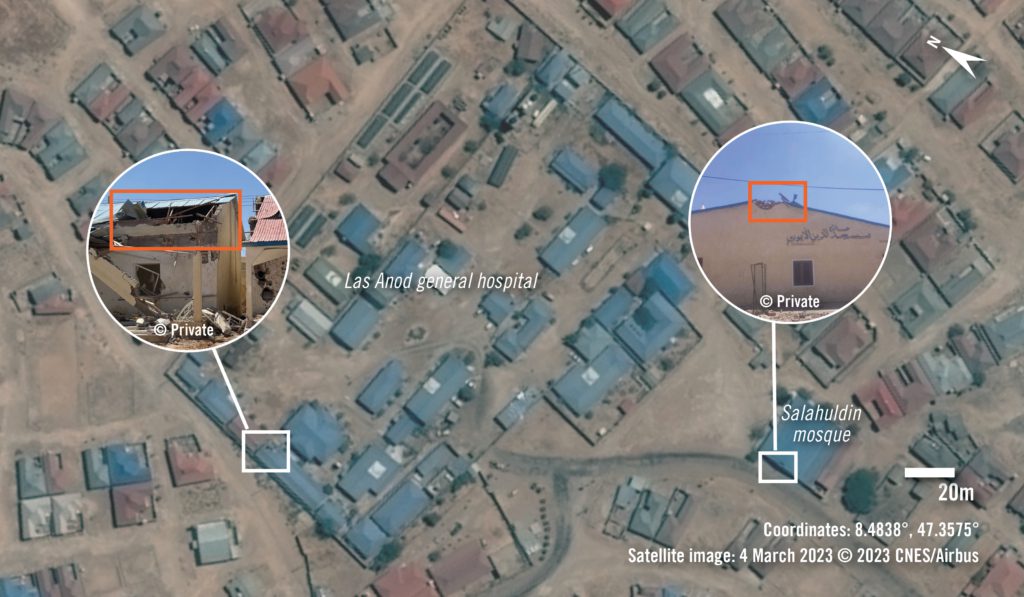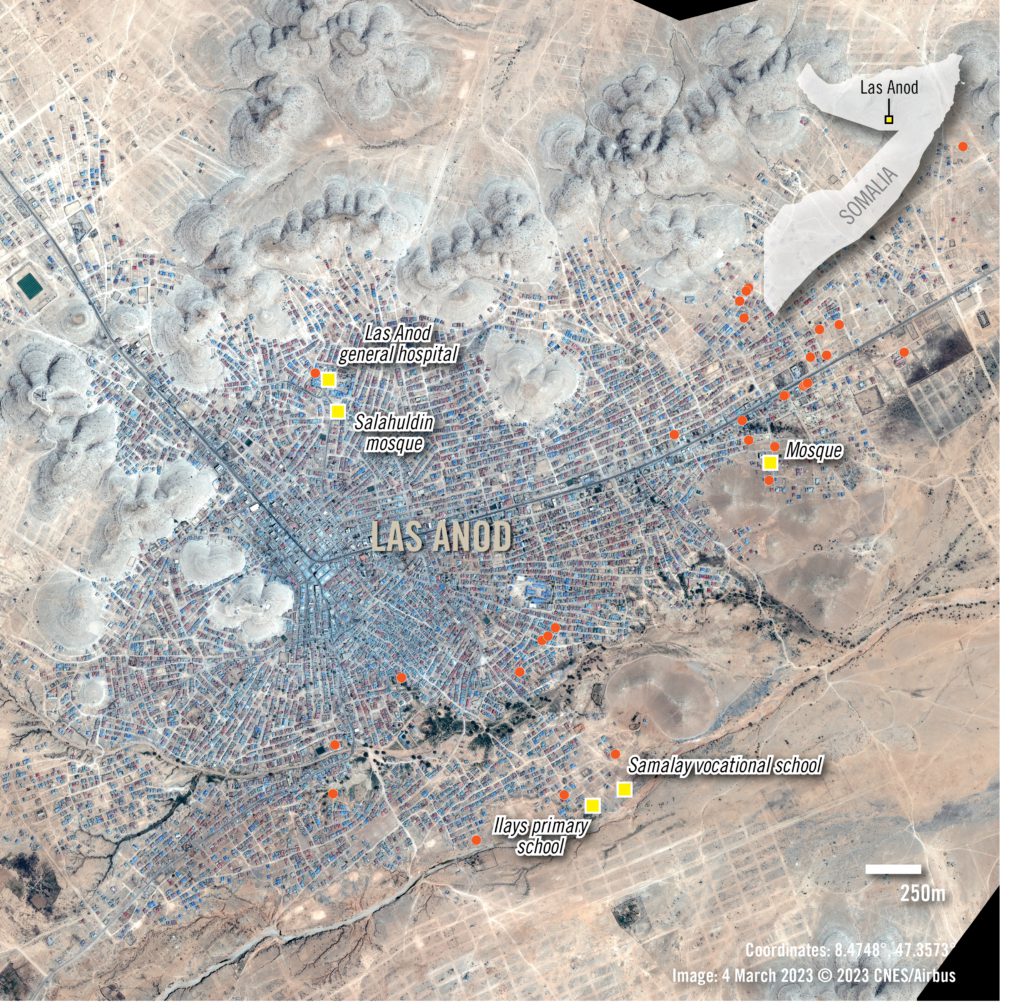Amnesty International interviewed 37 people in Las Anod, including victims, victims’ relatives, witnesses, doctors, and humanitarian workers. The organization also analyzed casualty numbers from five local hospitals in Las Anod, and reports from the media, NGOs and the Somaliland government
More than 100 people have been killed and over 600 injured including dozens of civilians amid fighting between Somaliland security forces and armed fighters affiliated with the Dhulbahante clan in Las Anod, Amnesty International said today, as it shares findings that Somaliland security forces indiscriminately shelled the town, damaging hospitals, schools and mosques, killing and injuring civilians, and displacing tens of thousands of people.
“All parties to the conflict in Las Anod must end indiscriminate attacks, commit to protect civilians and respect the rules of international humanitarian law. Hospitals and ambulances should never be targeted. There must be an independent investigation into all human rights and humanitarian law violations to ensure accountability for those responsible and reparation for victims,” said Tigere Chagutah, Amnesty International’s Regional Director for East and Southern Africa.
All parties to the conflict in Las Anod must end indiscriminate attacks, commit to protect civilians and respect the rules of international humanitarian law
Tigere Chagutah, Regional Director, East and Southern Africa, Amnesty International
Humanitarian groups reported that between 154,000 to 203,000 people were displaced to neighboring towns and villages, while some crossed the border to Ethiopia. They are now in need of urgent humanitarian assistance. Those worst affected are women, children, and older people.
“This humanitarian crisis is compounded by the effects of the ongoing, devastating drought in the region. All parties must allow and facilitate humanitarian organizations’ unfettered access to civilians in need of assistance in Las Anod and other affected areas,” said Tigere Chagutah.
From 6 February to 6 March, Amnesty International interviewed 37 people in Las Anod, including victims, victims’ relatives, witnesses, doctors, and humanitarian workers. The organization also analyzed casualty numbers from five local hospitals in Las Anod, and reports from the media, NGOs and the Somaliland government.
Civilian deaths and injuries
Among the civilians killed were women, children, older people with health conditions, and healthcare workers. They were mostly killed during indiscriminate attacks involving rockets, mortars, and other explosive weapons with wide area effects, which should never be used in populated areas. In dense urban settings, many unguided explosive weapons, such as the inherently inaccurate 107mm rockets, are too imprecise to distinguish between military objectives, civilians, and civilian objects. Their use in such circumstances violates the prohibition in international humanitarian law of indiscriminate attacks.
On 6 February, on the first day of fighting, Rayan Abdullahi Ahmed, a seven-year-old girl, was hit and killed by a munition while inside her aunt’s house in the Samalay neighborhood, in southern Las Anod.
My daughter was buried in a mass grave with several other people who died that day.”
Victim's mother
Rayan’s mother told Amnesty International that her daughter was hit in the head by a large shrapnel that killed her instantly: “Relatives took her to the Las Anod general hospital, but she was already dead. My daughter was buried in a mass grave with several other people who died that day.”
On the same day, Amina Jama Ibrahim, a 38-year-old woman, was hit by a munition while inside her house in the Ex-Control neighborhood, in eastern Las Anod. Close relatives of Amina, including her mother in-law, told Amnesty International that her body was torn apart when she was struck by a munition and that her remains were buried in Las Anod that evening.
Her mother in-law said: “Amina was planning to leave Las Anod that same day, but her life was cut short before she could leave. She left behind seven children, including one sick boy who is suffering from macrocephaly and who was with her during the attack. Her house was destroyed, and the sick boy is now with me in Kalabeedh.”
On 7 February, Mohamed Hassan Abdi, a paramedic, was in an ambulance when the vehicle was hit by a munition. He was evacuated to a hospital in Mogadishu two days after the incident but died on 21 February.
On 11 February, Abdisalam Saed Muse, a nurse volunteer with the Somali Red Crescent Society (SRCS), was hit and killed by a stray bullet while at Gargaar hospital. His relative and three of his colleagues told Amnesty International that the bullet struck him in the chest, killing him immediately. He was buried in Las Anod that same day.
On 21 February, Saynab Yusuf Dheeg, a 38-year-old woman, was hit and killed by a munition while sitting with four other women near her house. According to her aunt, who was one of the women with her when she died, a mortar struck the area where they were sitting, killing Saynab. “We were engulfed with dust and smoke; we could not see each other. I heard Saynab scream. When we cleared our eyes, I found Saynab soaked in blood. She was already dead. We all started crying and she was taken to the general hospital by her relatives.” A woman who washed Saynab’s body and prepared her for burial said she had a large hole on the left side of her chest. Saynab was buried in a mass grave later that night.
Five doctors interviewed by Amnesty International said that most of the people they treated had bullet wounds and other injuries caused by shrapnel from rockets. Amnesty International also established that dozens of injured people were transferred to hospitals in Garowe and Mogadishu.
Indiscriminate ground attacks on Las Anod town
According to witnesses, significant damage has been caused to hundreds of civilian buildings including homes, mosques, schools and one hospital because of indiscriminate attacks allegedly by the Somaliland forces who have been trying to take over the town by firing rockets from military bases on the eastern side of the city.
Interviewees told Amnesty International that Somaliland forces were initially based in the eastern and western outskirts of the city, while armed fighters affiliated with the Dhulbahante clan were mostly within the city. Most attacks were coming from the eastern side.
The Las Anod general hospital has been hit at least four times since the fighting started. MSF reported that the hospital was hit during fighting on 28 February, causing partial damage to the structure and bringing a stop to activities in the pediatric ward and the blood bank.

A doctor at Las Anod general hospital also told Amnesty International that the hospital’s oxygen plant was damaged on 8 February and is no longer functioning, and that one of the hospital’s ambulances was badly damaged on 7 February.
Amnesty International received and reviewed more than one hundred photographs showing damage to Las Anod, including at least 38 homes. An engineer who teaches at a university in Las Anod said he documented over 300 homes that were damaged during the attacks. Ten other residents from Las Anod said their homes were damaged by mortar attacks. Interviewees said that the Sayidka, Samalay, Masalaha and Xafada Bariga neighborhoods were damaged the most. Amnesty International documented damage to two mosques (Al-Huda and Salahuldin), and three schools, including Samalay Vocational School for Women and the Ilays primary school.
Amnesty International compared and analysed satellite imagery of Las Anod town from before the attack – on 24 December 2022, and after – 4 March 2023. Over 30 structures appear visibly damaged in the imagery and seven of those locations align with ground photos received, including the Las Anod general hospital, Salahuldin mosque and several homes. A lot of the damage visible in imagery was concentrated on a road on the eastern side of the city, further corroborating testimony collected from interviewees.

The organization analyzed several photos showing remains of weapons collected from various parts of the town and confirmed that they were remnants of 107mm rockets, and the damage to the homes was consistent with being struck by rocket warheads of that size. Amnesty International was not able to identify the country of manufacture but assessed them to be weapons commonly used in Somaliland.
Displacement and humanitarian crisis
Humanitarian groups have raised concerns that the displaced communities are living in dire conditions with inadequate housing and scarce medical supplies. They are also subject to movement restrictions for safety reasons and are facing heightened eviction risks. An estimated 89 percent of those displaced are women and children.
According to the latest Integrated Food Security Phase Classification (IPC), this new wave of displacement comes at a time when about 214,000 people in the Sool region are experiencing crisis or acute food insecurity due to severe drought, compounding the hardship experienced by those displaced by the conflict.
Somaliland authorities say that they are committed to providing basic necessities including food, water and medical equipment to the people of Las Anod in coordination with local and international humanitarian organizations. However, three humanitarian aid workers interviewed by Amnesty International said that humanitarian access to Las Anod is a major challenge due to the widespread violence and some restrictions from authorities.
Background on the Las Anod crisis
Somaliland is an area in northwestern Somalia. It declared its independence from Somalia in 1991. However, it has not been formally recognized by any country.
Las Anod is in the southeastern part of Somaliland and is the capital of the disputed region of Sool. The town is largely inhabited by the Dhulbahante, members of the larger Darod clan. Las Anod has been under the control and administration of Somaliland since 2007. Over the years, the Dhulbahante have expressed grievances against the Somaliland authorities including allegations of targeted assassinations and they have also accused Somaliland of marginalizing them and subjecting their region to what they call “economic embargo”.
On 26 December 2022, the assassination of a Dhulbahante local politician, Abdifatah Abdullahi Abdi, in Las Anod town by unknown armed men triggered widespread protests. Somaliland security forces responded by using excessive, including lethal force, killing and injuring dozens of protestors.
Following continued anger and widespread protests about the killings, Somaliland authorities withdrew their security forces from Las Anod. This paved the way for prominent Dhulbahante personalities including clan elders to enter the city. The elders held a consultative meeting from 28 January to 5 February. On the last day of the meeting, the delegates issued a declaration that they are not part of Somaliland’s administration.
Immediately after the declaration, clashes started between Somaliland security forces and armed fighters affiliated with the Dhulbahante clan on 6 February, escalating into a situation of armed conflict. Both sides blamed each other for starting the fighting.
Tags: Somaliland, civilians, investigation, attacks.
Myanmar: ‘Deadly attack’ on festival highlights paraglider threat to civilians
DRC: Authorities must lift ‘state of siege’ now
Africa: Attacks on journalists on the rise as seek to suppress press freedom
Sudan: New conflict escalation exacerbates 20 years of suffering
Sudan: Parties to the conflict must ensure protection of civilians
Contact Us
Regional - Américas
Calle Luz Saviñón 519, Colonia del Valle Benito Juárez, 03100. Ciudad de México, México
Global
1 Easton Street, London WC1X 0DW. Reino Unido.